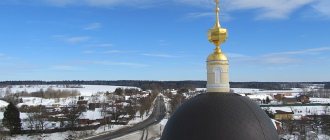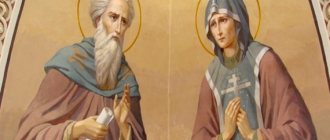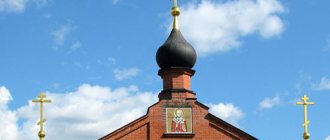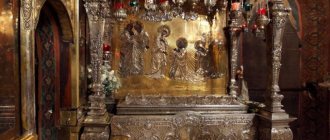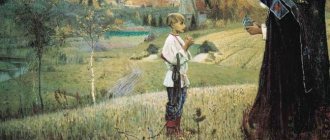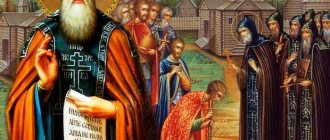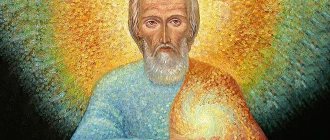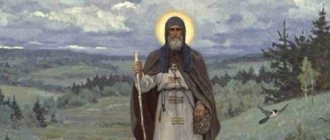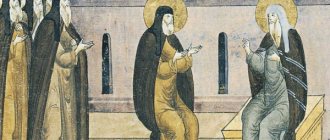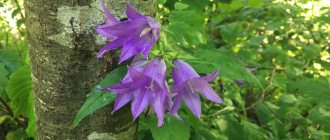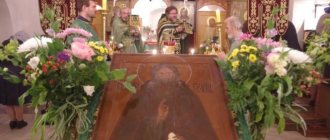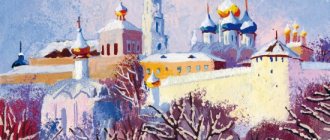Mir
Russia Moscow region Khotkovo Pokrovsky Khotkov monastery Map loading in progress...
{"format":"leaflet","minzoom":false,"maxzoom":false,"limit":50,"offset":0,"link":"all","sort":[""], "order":[],"headers":"show","mainlabel":"","intro":"","outro":"","searchlabel":"\u2026 \u0441\u043b\u0435\ u0434\u0443\u044e\u0449\u0438\u0435 \u0440\u0435\u0437\u0443\u043b\u044c\u0442\u0430\u0442\u044b","default":"","import-annotation":false,"width ":"auto","height":"350px","centre":{"text":"","title":"""link":"""lat":56.2498659999999972569639794528484344482421875,"lon": 37.9938929999999999154169927351176738739013671875,"icon":""},"title":"","label":"","icon":"","lines":[],"polygons":[],"circles":[ ],"rectangles":[],"copycoords":false,"static":false,"zoom":8,"defzoom":14,"layers":["OpenStreetMap"],"image layers":[] ,"overlays":[],"resizable":false,"fullscreen":true,"scrollwheelzoom":true,"cluster":false,"clustermaxzoom":9,"clusterzoomonclick":true,"clustermaxradius":80, "clusterspiderfy":true,"geojson":"","clicktarget":"","showtitle":true,"hidenamespace":false,"template":"","userparam":"","activeicon": "","pagelabel":false,"ajaxcoordproperty":"","ajaxquery":"","locations":[{"text":"\u003Cb\u003E\u003Ca href=\"/palomnik/%D0% 9F%D0%BE%D0%BA%D1%80%D0%BE%D0%B2%D1%81%D0%BA%D0%B8%D0%B9_%D0%A5%D0%BE%D1%82% D1%8C%D0%BA%D0%BE%D0%B2_%D0%BC%D0%BE%D0%BD%D0%B0%D1%81%D1%82%D1%8B%D1%80%D1% 8C\" title=\"\u041f\u043e\u043a\u0440\u043e\u0432\u0441\u043a\u0438\u0439 \u0425\u043e\u0442\u044c\u043a\u043e\u0432 \u043c\u043 e\u043d\u0430\ u0441\u0442\u044b\u0440\u044c\»\u003E\u041f\u043e\u043a\u0440\u043e\u0432\u0441\u043a\u0438\u0439 \u0425\u043e\u0442\u044c\u 043a\u043e\u0432\u043c\ u043e\u043d\u0430\u0441\u0442\u044b\u0440\u044c\u003C/a\u003E\u003C/b\u003E\u003Chr /\u003E\u003Ca href=\"/palomnik/%D0%A1%D0%B2% D0%BE%D0%B9%D1%81%D1%82%D0%B2%D0%BE:%D0%90%D0%BD%D0%BD%D0%BE%D1%82%D0%B0%D1 %86%D0%B8%D1%8F\" title=\"\u0421\u0432\u043e\u0439\u0441\u0442\u0432\u043e:\u0410\u043d\u043d\u043e\u0442\u0430\u0446\u0438\ u044f\u003E\u0410\u043d\u043d\u043e\u0442\u0430\u0446\u0438\u044f\u003C/a\u003E: \u043f\u0440\u0430\u0432\u043e\u0441\u043 b\u0430\u0432\u043d \u0430\u044f \u0436\u0435\u043d\u0441\u043a\u0430\u044f \u043e\u0431\u0438\u0442\u0435\u043b\u044c, \u043e\u0441\u043d\u043 e\u0432\u0430\u043d\u043d\ XIV \u0432. 1921, \u0432\u043e\u0437\u0432\u0440 \u0430\u0449\u0435\u043d \u0426\u0435\u0440\u043a\u0432\u0438 \u0432 1991 \u0433\u043e\u0434\u0443. \u041f\u0440\u0438 \u043c\u043e\u043d\u0430\u0441\u0442\u044b\u0440\u0435 \u0434\u0435\u0439\u0441\u0442\u0432\u0443\u0435\ u0442\u0434\u0435\u0442\u0441 \u043a\u0438\u0439 \u043f\u0430\u043d\u0441\u0438\u043e\u043d \u0438 \u0433\u043e\u0441\u0442\u0438\u043d\u0438\u0446\u0430 \u0434\u043b\u044f \u043f\u0430 \u043b\u043e\u043c\u043d\u0438\u043a\u043e\u0432.","title":"\u041f\u043e\u043a\u0440\u043e\u0432\u0441\u043a\u0438\u0439 \u0425\ u043e\u0442 \u044c\u043a\u043e\u0432 \u043c\u043e\u043d\u0430\u0441\u0442\u044b\u0440\u044c","link":""lat":56.249865999999997256963979452848 4344482421875,"lon":37.9938929999999999154169927351176738739013671875,"icon" :""}],"imageLayers":[]}
56.250742; 37.995152
Russia, Moscow region, Sergiev Posad urban district, Khotkovo, Kooperativnaya street
Khotkovo, Moscow region
Russia
Telephone:
8 (496) 543-000-5
Pokrovsky Khotkov Monastery
- an Orthodox convent founded in the first quarter of the 14th century. The monastery was closed in 1921 and returned to the Church in 1991. The monastery operates a children's boarding house and a hotel for pilgrims.
Saints Cyril and Mary of Radonezh lived in the village of Varnitsa near Rostov
Four miles from the city of Rostov the Great, near the Ishni River, in the village of Varnitsa, at the beginning of the 14th century there was a boyar estate of Cyril and Maria. The parents of Sergius of Radonezh led a pious life, showing humility and trusting in the Lord in prayer.
Icon of Saints Cyril and Mary with Life
More than once Cyril of Radonezh accompanied the Rostov princes to the war with the Golden Horde. Being a wealthy owner, boyar Kirill did not disdain land labor in peacetime.
The family led a godly life, fulfilling the commandments of the Lord and observing church canons. Saints Cyril and Maria helped the poor and gave alms.
Their special grace was hospitality. They provided their shelter to any traveler, pilgrim, or vagabond with a dear soul and God's prayer, shared their table, and packed their knapsack for the journey.
Fragment of the life from the icon. Saints Cyril and Mary lived modestly
About the old tradition
It is known about the surroundings of Khotkovo: there is an interesting church in the village of Vozdvizhenskoye, very close, ten kilometers from the city, is Radonezh and fifteen kilometers separate it from the city of Sergiev Posad and the ensemble of the Trinity Lavra of St. Sergius.
Nowadays, the tradition of pilgrimage visits to holy places and monasteries is being revived in Russia, even special excursion tours are being organized. The Trinity-Sergius Monastery has always been and remains the most visited.
There is an old tradition: believers who want to venerate Saint Sergius of Radonezh in the Lavra begin their pilgrimage from the village of Radonezh. This is the reverend’s second homeland; since childhood, these places were trodden far and wide by him. A transparent river, hills with forests all around, Nesterov’s picture comes to life in my memory, and here, it seems, is the same young birch tree and fir trees, near which the boy Bartholomew and the holy elder were talking...
There is a legend among believers that unrepentant sinners will under no circumstances end up in Radonezh. This is his peculiarity. Well, there their car will break down, or some other obstacle will arise on the way, but the blessed place will not allow them to come to it. Until they realize their wrongdoing and repent.
Then the pilgrims go to bow to the parents of the great saint, and only then head to the monastery.
During the service, Mary heard the threefold cry of an unborn child
Mary and Cyril's son Stefan was already growing up, when a sign came to Mary that she was to give birth to a child of the Lord. While in church at the Divine Service, Mary heard the baby’s exclamation three times, that by the grace of the Lord she should give the light of God’s chosen one.
The Venerable Mary heard the baby cry three times
Inspired by the sign, Mary was especially sensitive to her spirituality. She protected herself and her family from filth, strictly observed fasting, and prayed to the Lord for a long time to preserve the child of God in her womb.
Mary gave her word to dedicate the born child to the Lord
She made a vow in prayer to dedicate the baby to the Almighty and raise him according to Christian canons.
And on May 3, 1314, a boy, a blessed son, was born to them. On the fortieth day, the happy parents decided to bring him to church. Father Michael, who baptized him, named him Bartholomew.
Feeling that baby Bartholomew was special, he exclaimed:
“Rejoice, for this child is the chosen vessel of our God and the abode of the Holy Trinity.”
At baptism, the baby was given the name Bartholomew, fragment of the life
The road to the Lavra as a path to yourself
Stories
April 15, 2022 10 minutes Author: Dmitry Kotov 2828
This route is called differently: the road to the Lavra, the Tsar’s Path... The main pilgrimage route of Russia, along which even powerful kings walked on foot to bow to St. Sergius of Radonezh, in the Trinity-Sergius Lavra... “Atmosphere” spoke with one of the group of people developing this project. Eldar Orudzhev told us how and why to walk 120 kilometers, and what revelations await travelers along the way.
print version all stories
AT THE BEGINNING OF THE TRAIL
The idea of the road to the Lavra is not mine - people have been walking along it for many hundreds of years. Previously, it was believed that one had to come to the Trinity Monastery at least once a year. I started working on the trail two years ago, when I was working on the development of tourism and active recreation in the Central PPK, and now I continue it as a volunteer project.
The road to the Lavra is ideally suited to the format of a long walking trail. Its advantages are proximity to Moscow, historical content, and environmental friendliness. Along the road there are two large reservoirs, many attractions, forests... The Moscow part of the route passes through boulevards and parks with the minimum possible intersection of highways.
Of course, we are not the first in post-Soviet history to work on the trail to Sergiev Posad. Pilgrims from the Church of the Holy Trinity in Khokhly have been making a walking pilgrimage to the Lavra for more than 10 years. The difference between our approach is that we are not engaged in organizing hikes, pilgrimages or other one-time or periodic events, not in creating a tourist route, but in creating a pedestrian road as an object.
On March 23, 2022, the first “reconnaissance” hike along the road to the Lavra took place, and even earlier we tested the road several times on foot and on bicycles... Then more than two hundred people gathered - guys from RGUTIS, representatives of the Ministry of Culture of the Moscow Region.
We tried a route that was safe and interesting to follow - twenty-five kilometers, the first section outside of Moscow. We started from Taininsky, where the royal travel palace used to be located and the Church of the Annunciation was still preserved, and moved in the direction of the Pirogovsky reservoir. HISTORY AND LOGISTICS
In general, the road to the Lavra begins in Moscow, from the Iveron Chapel near the Historical Museum. Here, in the chapel, you can receive a travel document with a start mark and go to Sergiev Posad. The length of the trail is 120 kilometers. In times when the railway and Yaroslavl highway did not exist, the pedestrian road was shorter. And now you can shorten it by twenty to thirty kilometers if you don’t go to Khotkovo or Radonezh, but since these places are directly related to the history of Sergius of Radonezh, we believe that people should have the opportunity to visit them.
The Tsar's Path is also good because it fits perfectly with modern logistics. Relatively speaking, you can walk to Pushkino and return home by train, and next time start from the place where you stopped. Catherine II came up with a similar way of passing the road when she decided to visit the famous monastery. “The Empress, having left Moscow on foot, reached a certain place and returned to Moscow in a carriage. The next day she reached the place where she had reached the day before and walked again,” says the chronicles of that time.
Of course, there are also difficulties.
The infrastructure that accompanies hiking is being disrupted by the construction of large highways and dacha SNT. And we had an example when SNT blocked our path by writing a piece of paper: “You can’t walk!”, although a public road runs through the territory. But the difficulties can be overcome. The trail must be developed and made accessible not only to travelers, but also to people who permanently live in settlements next to it. Moreover, controversial issues should be resolved in favor of the interests of local residents, because the road will be truly popular only if it is in demand among people as part of the global infrastructure for active recreation. SPEED, AMBITION, JOY
The official record for walking (more precisely, running) the road to the Lavra is 16 hours 50 minutes. People fled in winter, December 30. One of the participants had the soles of his sneakers come off, so he did not want to leave the route and ran barefoot for three kilometers until they brought him new sneakers to the intermediate point. The pedestrian record is 24 hours 50 minutes. Covering the route on foot in one or two days is an ambitious task that not everyone can do. It’s easier not to walk 60 kilometers over rough terrain, but to run. If you go on foot, you should plan the entire daylight hours for the journey, do not stop, even eat on the go. This is rather an atypical option. An ordinary, unprepared person will conquer the trail in four to five days, with several stops.
One hundred pilgrims over the age of 60 recently walked the trail. The eldest was 85. We walked for quite a long time, in several stages - nothing, we got there, and with pleasure. Different people are walking. There are athletes, there are believers, there are simply people who are interested in history. The British came, the Chinese. Some travel the route by bicycle. There has already been a good tradition of cycling competitions on the Lavra bike challenge road. We don’t segregate people, the road is open to everyone, everyone chooses their own format. The more we can attract, the more people learn the history of our country and can have an interesting time near Moscow - the better. Soon television people will follow the trail - professional journalists, professional cameramen - who have conceived a series of ten films dedicated to this route. They took four days to complete.
I walked the Royal Path four times - starting from a four-day format and ending with a two-day one.
It's more interesting to go slower. More time to see the sights. For example, along the road there is a forest hermitage, built on the site of a church that was burned by the Poles - they failed to take the Lavra and were advancing on Moscow. In this monastery two people live and pray. The nature around is beautiful - mushrooms, berries... BEAUTY IN THE EYES OF THE WALKER
Before the revolution, before the construction of the railway, six hundred to seven hundred thousand people a year passed along the route. At the beginning of the 16th century, Baron Sigismund in his “Notes on Muscovy” mentioned that up to a million pilgrims arrived on pilgrimage. Can you imagine what a million people were like at that time? This is a colossal number!
We have chosen a route that leads to the maximum number of historical places and at the same time has minimal intersection with highways, is environmentally friendly and safe. This is mainly a forest road, and in the cities of Pushkino and Sofrino the trail passes through park areas. The route is interregional, it starts in Moscow and continues through the Moscow region.
About nineteen kilometers passes through the territory of Moscow: the famous “football” Nikolskaya Street, the Slavic-Greek-Latin Academy, where Lomonosov studied - the first higher educational institution in Russia. By the way, the academy also belonged to the Trinity-Sergius Lavra. The Nativity Monastery was founded with the blessing of Sergius of Radonezh, where the wife of the hero of the Battle of Kulikovo Vasily the Brave took monastic vows - this is one of the most ancient surviving monasteries. From the courtyard of the Trinity-Sergius Lavra on Olimpiysky Prospect, through Maryina Grove we get to the Rostokinsky Aqueduct. There, on the outskirts of Moscow, in the area of today's Alekseevskaya metro station, the first travel palace was located, where the kings exchanged their formal clothes for travel clothes to go to the Lavra. Then - Yauza Park with the Sviblovo estate.
In the Moscow region, in addition to the already mentioned Taininsky, we pass through the Pirogovsky forest, which ends with the Pirogovsky reservoir. Next is the city of Pushkino with a very interesting museum-dacha of Mayakovsky. Paradoxically, this object was restored by a local priest, Father Andrei. Here you can also put a stamp on the travel document. The very beautiful Uchinskoye Reservoir, Severny Park in Pushkino and the embankment of the Serebryanka River, the Muranovo estate, the village of Artemovo, which used to also be the courtyard of the Trinity-Sergius Lavra... Then - the Abramtsevo museum-estate, Khotkovo with the famous Stavropegial Convent, where Sergius’s parents are buried Radonezh. Then we go to the ancient village of Radonezh with the Metochion of the Trinity-Sergius Lavra and the source of St. Sergius of Radonezh, to the Church of St. Sergius on Semkhoz, built on the site of the death of Alexander Men. There are other interesting places - historical, religious, natural: parks, forests, rivers with bridges, lakes. In the village of Artemovo there is a spring of All Saints with 12 fonts. Nomad Park is also an interesting place.
FROM THE HEART
The Tsar's Path is also available for independent visits, and any section of it can be the starting point. We have developed several options for weekend hikes, in which you can walk not the entire trail, but separate sections of the tourist’s choice. There are hotels along the route; depending on the number of people and the complexity of the route, you can choose the number of stops.
Volunteers compiled and voiced an audio guide that described most of the attractions. In general, volunteers do a lot. Groups are led - including groups of elderly people - sometimes more than a hundred people per trip. We do not receive external funding for the project; we do everything at our own expense, on our own initiative, in our free time. We organize regular volunteer road cleaning camps. We chip in for materials, saws, axes and shovels, and work. Local residents join this project and cut down fallen trees.
It is thanks to volunteers that this road is filled with content, becomes diverse and interesting. I would like to note the special contribution of Yuna Yuzheva, Svetlana Savelyeva, Lyudmila Veterkova, Irina Golodnyuk, Polina Vlasova, Roman Nechay, Sergei Tolubaev, Alexander Sovetov, Sergei Potapov, Igor Silin, Dmitry Erokhin, Andrei Ivanov, Angelika Danyushina, Anna Maslennikova. Each of them is involved in some aspect of road development. We even have unofficial “positions” - “keeper of traditions”, “creator of comfort”, “tourism champion”.
The Trinity-Sergius Lavra (Father Anatoly and the head of the Pilgrimage Center Anton Novikov) provides great support.
The Trinity-Sergius Lavra issues certificates to those who come, greets them, helps to interact with various bodies and organizations, and develops international cooperation with similar projects. There was even a case when they met runners, giving them amino acids for recovery, which was very surprising and pleasing. OLD NEW ROAD
I can tell you how I see the prospects of the project, although in fact it may be much wider than I imagine. I see the trail as a pilot project for developing the country's non-vehicle infrastructure. Now in Russia there is not even legislation that describes what a non-motorized road is. A pedestrian road, according to modern Russian GOST, exists as a supplement to a road road (an engineering structure in the right-of-way). And the pedestrian network of Europe includes 70 thousand kilometers of main pedestrian roads, plus each country has its own extensive network - from 40 to 60 thousand kilometers of local pedestrian roads connecting various settlements.
Each long pedestrian road consists of a large number of small ones, which makes it possible to create a continuous pedestrian infrastructure. There is an interesting example - the Camino Santiago, the Way of St. James, one of the most famous pilgrimage routes in Europe. About 400 thousand people walk along it. The minimum length is 100 kilometers, the maximum is more than 3000 kilometers. In 1975, when the revival of this trail began, 18 people walked it, and now - 380 thousand. But in the old days, as I said, many more people walked along our road than along the path of St. James. We are collaborating with this project under the supervision of the Trinity Lavra of St. Sergius, we have big plans to exchange experience.
There is an example of the Canada Trail, which passes through thirteen provinces: from Nova Scotia in the east to the Northwest Territories. The total length is 24,000 kilometers. The route is designed to be accessible to the majority of the country's population—four out of five Canadians live within a thirty-minute drive of the route.
In 2022, we won the competition of the Ministry of Culture of the Russian Federation “The Best Green Route of Russia”, in which 79 regions participated. More than 200 trails were announced! I hope that other long non-vehicle routes will be created using the example of our road. According to the decree of the Moscow region government, our road is already included in the transport network. At the same time, I hope it will not become a city pedestrian road moved into the forest. Perhaps, in parallel with it, a bicycle path will appear - environmentally friendly, close to the natural environment. A design project for planning a linear facility (pedestrian road) is currently being prepared. We expect that by the end of the year the Road to Lavra will officially become a pedestrian road connecting several settlements in the country. It will be the first in the country to be officially registered as an extended pedestrian road.
Our goal is to create a unique world-class pedestrian facility in Russia and attract a large number of tourists, local residents, and pilgrims to this facility and to active and educational recreation.
Photo: dorogavposad.ru, Eldar Orudzhev, Sergey Kalugin.
Share:
From birth, Bartholomew observed fasting, which surprised his parents
Article “Is it possible to eat sugar during fasting” on hranitel.club
To the surprise of his righteous parents, Bartholomew kept fast from birth. On Wednesday and Friday he did not drink milk, and refused to eat on other days if Maria ate meat the day before. Accustomed to fasting in the womb, he set an example for his parents.
In the growing Bartholomew, the signs of being chosen by God were increasingly expressed. He respected his parents, showed humility and obedience, and prayed a lot. At the age of seven, the reverend parents sent the boy to learn to read and write so that he could read spiritual books himself.
Fragment of life: Youth Bartholomew asks his parents for blessings for monasticism
His brothers also studied with him: Stefan the elder and Peter the younger. Unlike his brothers, Bartholomew had a blast learning. His friends laughed at him and his teacher scolded him. At night, hiding from prying eyes, little Bartholomew cried for a long time and fervently prayed to God.
Life of the parents of Sergius of Radonezh
At the end of the 13th - beginning of the 14th century, 4 km from Rostov the Great, on the banks of the Ishni River, in the village of Varnitsa, there was the estate of the noble Rostov boyars Cyril and Maria (On the site of the estate of Cyril and Maria near Rostov there is now the Varnitsky Monastery).
Trinity-Sergius Varnitsky Monastery
Kirill was in the service of the Rostov princes - first with Prince Konstantin II Borisovich, and then with Konstantin III Vasilyevich, whom he, as one of the people closest to them, more than once accompanied to the Golden Horde. St. Cyril owned a fortune sufficient for his position, but due to the simplicity of the morals of that time, living in the countryside, he did not neglect ordinary rural labor.
Birth of Bartholomew, the future Sergius of Radonezh
The couple already had a son, Stephen, when God gave them another son - the future founder of the Holy Trinity Sergius Lavra, St. Sergius (in total, the couple had 3 children - Stephen, Bartholomew (the future Sergius of Radonezh) and Peter). Long before his birth, God's Providence gave a sign of him as a great chosen one of God.
According to legend, when his mother, pregnant with him, was in church, the child, to the great amazement of all those present, exclaimed three times in a loud voice in his mother’s womb. Firstly, at the beginning of reading the Gospel. Secondly, before the singing of the Cherubim. And finally, thirdly, at the moment when the priest exclaimed: “Let us take in, the Holy of Holies!” After this, the mother began to especially monitor her spiritual state. She constantly remembered that she was carrying a baby in her womb, who was destined to be the chosen vessel of the Holy Spirit. Maria observed fasting throughout her pregnancy, without giving herself any concessions.
Righteous Mary and her husband make a vow: if they have a boy, they will bring him to church and give him to God.
Baby Baptism
On May 3, 1314, great joy visited the righteous parents: a boy was born. On the 40th day after his birth, the Baby was brought to church to perform the sacrament of baptism on him. Priest Michael named the baby Bartholomew, for on this day (June 11) the memory of the holy Apostle Bartholomew was celebrated. This name in its meaning - “Son of joy (consolation)” was especially comforting for parents. The priest felt that this was a special baby and, overshadowed by the Divine Spirit, predicted:
“Rejoice and be glad, for this child will be the chosen vessel of God, the abode and servant of the Holy Trinity.”
Baby fasting
From the first days of his life, baby Bartholomew surprised everyone with his fasting. Firstly, on Wednesdays and Fridays he ate nothing at all. Secondly, on other days he refused mother’s milk if Maria ate meat. Abstained by fasting in the womb, the baby, even at birth, seemed to require fasting from the mother. And she began to observe fasting more strictly. First of all, I completely gave up eating meat. And even then the baby, except on Wednesdays and Fridays, always fed on her milk after that.
Difficulties with learning to read and write
When Bartholomew was 7 years old, his parents sent him to learn to read and write so that he could read and understand the Word of God. His two brothers also studied with him: the elder Stefan and the younger Peter. The brothers studied successfully, but Bartholomew was far behind them. The teacher punished him, his comrades reproached him and even laughed at him. Parents persuaded; and he himself strained all the efforts of his childish mind. Bartholomew spent his nights reading a book, and often, hiding from human gaze, somewhere in solitude, he wept bitterly about his inability. At the same time, he fervently and earnestly prayed to the Lord God:
“Give me, Lord, to understand this letter; teach me. Lord, enlighten and give understanding!”
But he was still not given a diploma. Until one day, sent by his father to the field to fetch horses, 13-year-old Bartholomew met an elder schema-monk. He asked him to come to his parents’ house; at dinner, the elder predicted to Cyril and Mary that “the boy will be great before God and people for his virtuous life.” Having blessed them, the schema-monk left. From then on, Bartholomew’s diploma, to his parents’ joy, began to come easily.
The parents of St. Sergius move to the Moscow lands
When Bartholomew turned 15 years old (around 1328), the Rostov Principality came under the rule of the Moscow Grand Duke Ivan Kalita. One of the Moscow boyars was appointed governor of Rostov, who oppressed and robbed the inhabitants. Many of the Rostovites began to leave the city. Among them was boyar Kirill. In addition to the oppression of the Moscow governors, he also went bankrupt, and did not want to stay where he once lived in wealth and honor. For his residence, he chose the small town of Radonezh in the Moscow lands (12 km from the Trinity Lavra, towards Moscow, there is the village of Gorodishche or Gorodok, which in ancient times bore the name Radonezh).
The elder predicted to Bartholomew that he would become special
One day a boy met an old man in a field. He invited the schema-monk to his parents’ house, and at dinner the elder predicted that Bartholomew would be great and virtuous before people and the Almighty. Having blessed the youth, the elder left, and from that time on Bartholomew began to easily read and write. He pleased his parents with his diligence and piety.
Fragment of life: Hospitality is one of the benefactors of Mary and Cyril
Saints Maria and Kirill and their sons are forced to move to Radonezh
Frequent Tatar-Mongol raids brought misery and poverty to Varnitsa. The principality suffered under the rule of Ivan Kalita. One of the Moscow nobles was appointed mayor to the Rostov lands, who continued to rob and oppress the local residents.
Rostovites began to leave the city. In his old age, Kirill and his family had to move to Radonezh. He was supposed to receive an estate and service from the Moscow princes. This responsibility was taken on by Cyril’s eldest son, already a family member, Stefan.
Reverend Kirill accompanied the Grand Dukes to the Golden Horde
Maria and Kirill ended their lives in the monastery
At the end of their lives, Kirill and Maria decided to go to the Khotkovsky Monastery of the Intercession of the Blessed Virgin Mary, which was both female and male.
They took monastic vows, and then became schema-monk Kirill and schema-nun Maria. In the same monastery, their eldest son Stefan, who by this time had become a widower, took monastic vows.
Fragment of life: Saints Cyril and Mary take monastic vows at the Khotkovsky Monastery
Before their death, in 1337, Mary and Cyril blessed Bartholomew to become a monk. The Khotkovo Intercession Monastery became their last refuge and the place where the saints were buried.
Other attractions of Khotkovo
Since you are in Khotkovo and have seen its main attraction - the oldest convent in the Moscow region, the Pokrovsky Convent, then take the opportunity to see another remarkable thing - the unique railway bridge over the Pazha River. It is also a bridge over the highway.
Look for it on the map next to the roundabout. On one side you can see the roundabout and the city, on the other there is a magnificent view of the Intercession Khotkov Monastery and the surrounding area.
The height of the bridge over the Pazha River flowing somewhere below is 35 meters. A real miracle of engineering. It was built in the 19th century and reconstructed in the middle of the last century. Although the grandfather of bridge construction is already 150 years old, hundreds of loaded trains pass over it every day.
To be fair, it should be noted that both the bridge itself and the man who created it, designer A. Rekhnevsky, deserve a separate story.
Well, we go further, to another Khotkovo attraction - the Nomad Ethnopark. See you soon, friends!
In order to see the relics of the saints, you need to get to the Intercession Monastery
To this day, their holy relics are located in Khotkovo, in the St. Nicholas Cathedral of the Intercession Monastery. The monastery is located at the address: Moscow region, Sergievo-Posadsky district, Khotkovo city, Kooperativnaya street, possession 2.
From Moscow you can get by train, departing from the Yaroslavsky station to Sergiev Posad, get off at the Khotkovo station. From the opposite side of the station, a bus leaves for the monastery. From the final stop it takes about 10 minutes to walk.
Official website of the Intercession Monastery in Khotkovo
More information about how to get there can be found on the official website of the monastery.
Domes in Russia are covered with pure gold
This is how Vladimir Vysotsky sang. But the bard was wrong - neither domes, nor crosses, nor church utensils are covered with pure gold. An alloy of metals is always used - 96 parts of gold and two parts of silver and copper. It is this composition that makes the domes with crosses “burn”, scattering a scattering of sunbeams around.
I look up and think how difficult it was for the gilders to work on the dome of St. Nicholas Cathedral - if you stumbled, there was 44 meters of height behind you!
There, at the top, they build a house out of polyethylene - protection from birds, rain and dust. The craftsmen perform their work in climbing harnesses, like steeplejacks, with gauze bandages on their faces. In the summer the dome gets hot, it’s stuffy and hot under the polyethylene. Salted people perform jewelry work: they overlap a special varnish so that the seams are not noticeable, ringing petals of gold foil...
The monastery founded by Sergius of Radonezh was dedicated to the Trinity
The rumor about Sergius's hermithood spread throughout the area and soon people began to flock to him. Although St. Sergius dissuaded them from staying here for a long time, he could not refuse hospitality.
New cells began to grow under the centuries-old pines of the Radonezh Forest. They surrounded the area with a palisade, built a vegetable garden, and lived modestly and quietly.
The monastery founded by Sergius of Radonezh was dedicated to the Holy Trinity and received the title of Trinity Lavra.
Trinity - Sergius Lavra, founded by St. Sergius of Radonezh
The life of St. Sergius, described by Pachomius the Serb, tells that the abbot often went to Khotkovo to bow to his parents. He commanded the travelers heading towards him to first go to the Intercession Monastery and pray to the Monks Mary and Cyril.
About Christian virtues
Suddenly, a girl dressed in black appeared from somewhere near me. What are you doing?! How did you get here? How - yes along the path. And I don’t do anything that is worth making a fuss about: I walk slowly, look to the left and down - near the path there is a steep slope, below are the remains of some kind of structure and a hole has been punched in the ancient stonework.
The young nun was flying towards me at high speeds. She clucked excitedly that it was forbidden to come here, and under no circumstances was it permissible to take photographs. But why? I turned back to the wall with the hole. Protects my eyes from the unsightly picture of construction? Come on - this kind of thing happens at every step, we’ve seen it and seen it again. Hardly. Or... is there some kind of secret hidden here and I inadvertently approached it?
A girl in black, breathing garlic at me, pressed me and muttered: “Only with the blessing of Mother Olympias!” A person in the rank of angel had the skills of a real security guard.
There was nothing to do, I went out onto the central path and, thinking about what had happened, quietly walked towards the exit.
Then two women in hoods came out of the house a little ahead of me, one after the other. I immediately forgot about what happened. One had a cross hanging on her chest - this is how church hierarchs walked around the Trinity Lavra. It was inexpressibly interesting - for the first time in my life I met face to face with a general from the church. We drew level and I looked into her eyes. Purely like woman to woman.
What did I expect to see? Well I do not know. After all, it’s not just her clothes that distinguish her? After all, she is a nun, that is, different. Not like all the women I have known so far. She is from a different orbit. Something was revealed to her, for the sake of which she refused to create a family, love, and the children she could have given birth to. What does it feel like to give up the worldly? What makes her eyes sparkle?
She answered me with an unblinking and hard look from her long eyes. There was not an ounce of meekness, humility, kindness or universal love for humanity in them; these were the eyes of a warrior who had already raised his sword for battle. Or the look of a demanding and powerful plant director, who saw goofing students in the shop during working hours who did not identify their superiors in a timely manner.
Their gazes crossed and I was the first to look away. Then I found it on the Internet - this was the same Mother Superior Olympias. But, you know, I can’t forget her look. And I think that in order to maintain an exalted attitude towards the institution of the church, a significant distance from high-ranking servants of God is useful. So as not to see how much earthly there is in them.
Saints Sergius, Cyril and Maria are considered intercessors against illnesses and disasters
The chronicle of the Intercession Khotkov Monastery testifies that prayer to St. Sergius and his parents saved people from serious illnesses. Reverends Maria and Cyril are considered intercessors in times of national disaster.
Thus, during the cholera raging in Russia, the monks from Khotkovo prayed to their intercessors, the Monks Mary and Kirill, for deliverance from the terrible illness. From August to December, the vigilant Psalter was read, water prayer services were read, and through prayers to the heavenly patrons the monastery got rid of a terrible illness. This was in 1770.
Pokrovsky Khotkov Monastery, where the holy relics of St. Cyril and Mary are kept
During a repeated outbreak of cholera in 1848, icons with prayer chants were carried around the cells, which miraculously helped to prevent the monks from getting sick.
Khotkovo Archpriest Alexy Lebedev talks about the miraculous healing of a peasant woman who fell into the river and fell ill with rheumatism. She lay bedridden for twelve long years.
On one of the long, painful nights, she dreamed of an old man in a robe, who told her to call upon St. Sergius and Mary and Cyril for help, and after blessing her, he disappeared.
Waking up, the peasant woman felt relief and began to pray day and night to the holy intercessors and the Lord. When she was able to walk, she went to the Intercession Monastery to venerate the relics and thank the patron saints Sergius, Maria and Cyril.
Saints Cyril and Mary of Radonezh, who gave Saint Sergius of Radonezh to Christians
The saints helped in establishing family relationships, in moral and spiritual education, and prayed to them for mental and physical healing, which they still pray for today.
Prayer to Saints Cyril and Mary:
“O servants of God, St. Cyril and Mary! Even though you have ended your natural temporary life in body, you do not depart from us in spirit; you guide us to Christ God, instructing us to walk according to the commandments of the Lord and to bear our cross and follow our Master. You, venerable ones, together with our reverend and God-bearing father Sergius, your beloved son, have boldness towards Christ our God and towards His Holy Mother of God. Be prayer books and intercessors for us, unworthy, living in your holy monastery, and you are its rulers. Be the helpers and intercessors of God's gathered squad, so that those who live in this place and come with faith, preserve by your prayers, remain unharmed from demons and from evil people, glorifying the Holy Trinity, the Father and the Son and the Holy Spirit, now and ever, and forever centuries. Amen".
By leaving a comment, you accept the user agreement
Wonderful are your works, Lord!
Wherever you go after leaving Prestolnaya, you will be accompanied along the road by fir trees, birch trees, linden trees and, of course, domes. 60 km from Moscow to the northeast and you are in the vicinity of Khotkovo.
And they are very picturesque: Pazha, a transparent and shallow river, whimsically meanders like a blue ribbon across the area until its waters merge with the waters of the Vorya River. There are many deep ravines with steep slopes and wild raspberry bushes, small water meadows, and groups of pine trees and birch groves growing on the steep hills. The eyes never tire of watching the constantly changing landscape, the soul is saturated with impressions and emotions - how beautiful the native spaces are!
About 22 thousand people live in the city on the hills of Khotkovo, but what interests us now is not the city, but the monastery that gave it its origin. On a wide expanse between the slope of the Komyakinsky ravine and the Pazhey river, a high cape stretches like a tongue.
There is a compact ensemble of an ancient monastery on it. The monastery is the high-altitude dominant of the area - not only in the spiritual sense, but also in the most literal sense. It’s amazing how a building of a religious nature has become a harmonious part of the natural landscape and the main decoration of the area.
After just a few minutes of contemplation of the Khotkov Monastery, I would like to say thank you to the scientist and church leader Alexander Sergeevich Nekrasov and his comrades, who with great difficulty achieved in 1960 the assignment of the status of a monument of history and culture to the dying monastery ensemble.
During the years of Soviet power, much of our ancient heritage disappeared. How many beautiful churches and monasteries were lost then (take, for example, the glorious city of Kalyazin, where we recently visited), noble estates were destroyed (as, for example, in the wonderful village of Tishkovo), and stolen for building materials from ancient mansions...
We approach the entrance to the monastery. This is the southern so-called Water Gate. On both sides of them there are yellow two-story buildings symmetrically located, with a sign on them. We read - the building of an almshouse, XIV-XVII centuries. A single-domed temple rises above the gate like a tower - yellow, green, white, and a small golden dome floats above it.
The gate itself to the women's monastery is guarded by a white marble lion with inappropriate, but very clearly expressed, signs of its belonging to the male sex. We turn away from the immodest beast and go inside the Intercession Khotkov Monastery and walk along the neat pedestrian paths.
